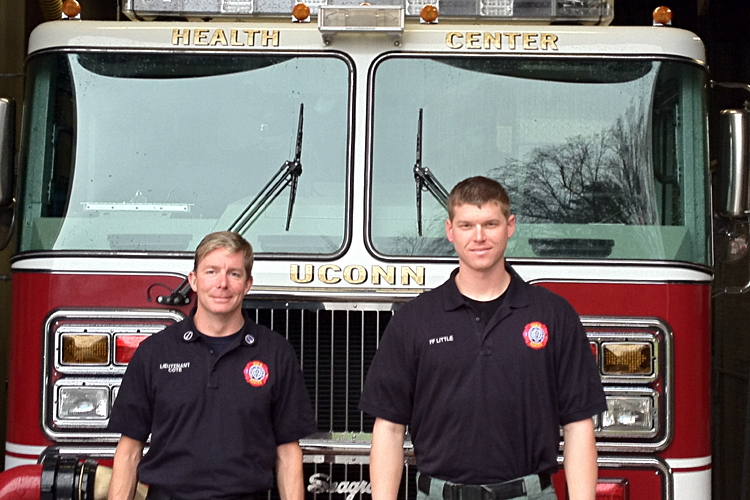
Quick work by paramedics, emergency department staff and the cardiac catheterization lab led to a heart attack patient undergoing a life-saving angioplasty in record time.
UConn Fire Lt. Wendell Cote and firefighter Brian Little, paramedics based out of the Health Center, responded to the Farmington home of Ramesh Nar, 63, Monday morning, as did local first responders from the town of Farmington.
Recognizing Nar might be suffering a heart attack, Little and Cote immediately performed an electrocardiogram and interpreted the reading as signaling a possible blocked coronary artery. Using a device known as a LifePak, they transmitted the data wirelessly from Nar’s home via the Physiocontrol LifeNet ECG transmission system. A radio call to the emergency department soon followed.
“Dr. Thomas Regan was already reviewing the transmitted ECG when the medics called with their report on the patient’s condition,” says EMS coordinator Peter Canning. “He agreed the patient was suffering a heart attack and immediately activated the hospital’s cardiac cath team.”

Regan, who was the E.D. physician on duty, along with Dr. Michael Azrin, director of interventional cardiology in the Pat and Jim Calhoun Cardiology Center, and cardiac catheterization lab staff, met Nar at the door, fully prepared to get right to work on him.
“They explained to me that in between two coronary arteries, there was one branch that was clogged,” says Nar, who had never experienced a heart attack before. “They say it was mainly from stress.”
Azrin performed a radial artery access angioplasty, clearing the blockage with a balloon and stenting the blocked vessel by way of a wrist incision. The elapsed time of 21 minutes between Nar’s arrival at the hospital and Azrin’s procedure is the Health Center’s fastest “door-to-balloon” time on record, and among the fastest in the region.
The ideal door-to-balloon time is less than 90 minutes. Every minute saved during this crucial period helps preserve heart muscle, increasing the likelihood of survival and preservation of normal heart function.
“The Health Center has made drastic strides and continues to see improvements in times that are already likely the best in the area. We have had times of 23 and 24 minutes before,” Canning says. “The role Dr. Regan played was pivotal. As the link between the field and the cath lab, any hesitation on his part would have significantly added to the door-to-balloon time. On the EMS side, the medics are doing a rapid 12-lead and rapid transmission and notification so that the hospital is preparing the cath lab while the medics are still at the patient’s side in the patient’s house. And the cath lab did its usual stellar job.”

Roughly 90 percent of cardiac catheterizations in the U.S. are done by way of a major leg artery. But interventional cardiologists at the UConn Health Center have expertise in – and regularly use – the radial artery access technique, which results in less bleeding and faster recovery time.
“This is a wonderful example that rapid revascularization can clearly be done with radial artery access,” Azrin says.
“I feel perfect,” Nar said, as he was preparing for discharge 48 hours after the procedure. “I’m ready to go home, ready to work.”
Follow the UConn Health Center on Facebook, Twitter and YouTube.



